- Author Arianna Cook [email protected].
- Public 2024-01-12 17:55.
- Last modified 2025-01-23 09:40.
The history of the origin of the breed, a description of the standard of appearance of a Thai cat, features of the character of the pet, health and tips for maintaining it, recommendations for caring for the animal, the price of a kitten. Thai cat is a native of Thailand with a rich history. It was such a cat, according to many legends, that the Buddha himself blessed and as a gift he rewarded a purr of heavenly color with his eyes. According to many historians and scientists, the modern Thai cat is none other than the Siamese in its ancient, primordial form. But whether this is true - no one knows for certain, some agree with this statement, while others touchingly argue that these cats are one and only. Be that as it may, this animal has a huge number of advantages, for which it has been loved and revered for many years and even centuries.
Thai cat: the history of the origin of the breed
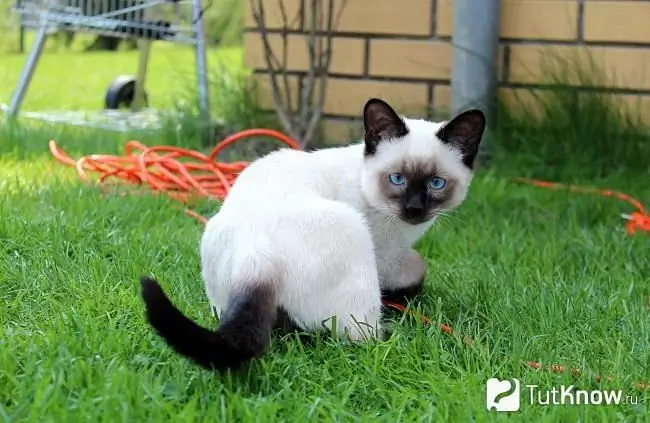
When scientists began to study the pedigree of these amazing purrs, the first thing that was drawn to their attention was that this species of cats is very, very ancient. The first mention, namely a drawing of a Thai cat in the ancient Siam manuscript "Book of Poems about Cats" dates back to the middle of the XIV century. This work of art has survived to this day in Bangkok at the National Laboratory.
The locals really appreciated their cats, and for this reason they completely refused to share their fluffy property with tourists from other countries. So Thai cats did not have the opportunity to be exported abroad until the end of the 19th century. But everything changed when the Emperor of the Russian Empire received an unusual gift from the Siamese king Chulalongkorn - over two hundred cats, they were exactly Thai cat. So these beautiful purrs soon spread to the luxurious estates of the Russian rich. A little later, these live presents from Thailand have already conquered the hearts of residents of other countries of the European continent, and in the 20s of the last century, Thai cats were already, in all, flaunted on the territory of the United States.
Representatives of felines with such an unusual appearance immediately became interested in both European and American felinologists. And everyone began to diligently select work, the only difference is that some of the breeders decided to improve the breed a little, changing some features of the appearance. And the other half worked simply to increase the population of animals with a noticeable color and bright blue eyes. As a result, it all boiled down to the fact that two varieties appeared in the world at once - the Siamese, which was slightly corrected, and the Thai, whose appearance remained intact.
Already at the end of the last century, Thai cat were regular participants in large-scale cat exhibitions and competitions, the breed was recognized by many eminent felinological associations. But such a finest hour did not last very long. Siamese cats, for unknown reasons, interested people more, and feline organizations decided to close down such a variety of cats as Thai. However, some enthusiasts are still breeding them, and there are people who dream of such pets. For this reason, if a breeder declares a Thai cat as a participant in an exhibition, then if it meets the former standard, they have no refusal.
There are many legends and stories floating around cats from Thailand, no one knows how true they are, but the most famous one says that the inhabitants of Ancient Siam trusted their purrs so much that they had their own responsible mission. The Thai cat was the guardian of the sacred cup, and the animal performed its duties so carefully that it even broke its tail, twisting it around the object, for reliability. In gratitude for such faithful and devoted service, the Great Buddha awarded the Thai cat with an amazing eye color that looks like the sky in sunny weather.
Thai cat: a description of the official standard of appearance

- Head The configuration of cats of this breed most of all resembles a circle, with smooth outlines and slightly plump cheeks. Well visualized forehead. The mustache pads protrude slightly above the overall surface. A slight bend can be seen in the projection of the eyes.
- Eyes Thai cat can even be called huge, especially in relation to the overall size of the head. Their shape is rounded, which gives the animal's muzzle a special charm and prettiness. As for the iris colors, the standard of the variety allows for a perfect riot of colors, but in the blue color range. Depending on the color of the eyes, the cost of the cat may also differ, the more pure and saturated the shade, the more expensive the pet is.
- Auricles cats from Thailand are very neat, wider in the projection of the base and smoothly taper to noticeably rounded tips. The ears are located very far from each other.
- Caudal process, whatever is said in the legends and epics, even and straight, without a single break and bend. In terms of duration, as well as in average diameter, it expands from a narrower, pointed tip towards the base part.
- Limbs Thai cats of medium length, in relation to the general parameters of the body, are very harmonious. Strong, muscular and very stable, ending in small, round paw pads.
- Torso Thai cat is of medium size, not elongated, more like a cylinder in shape. Due to their parameters, such animals may seem fat at first glance, but this is not so. Their body weight usually varies from 3.5 to 8 kg. Males are much larger than females.
- Wool Thai cats are very pleasant to the touch, soft, extremely dense and devoid of additional undercoat. Fits tightly to the skin of the pet. It glitters and shimmers very beautifully in the sun. In terms of texture, many people compare the fur coat of these purrs with minks.
As for the color, only one variety is allowed - color point. But the shades can be different: seal point, chocolate, blue, lilac, caramel, brown-gray, zannamon, fawn, red point, cream, cake, brown and many others. The points are located on the face, ears, paws and tail. You should know that the name of the color is determined precisely by the color of the darker inclusions.
Character features of the thoroughbred Thai cat
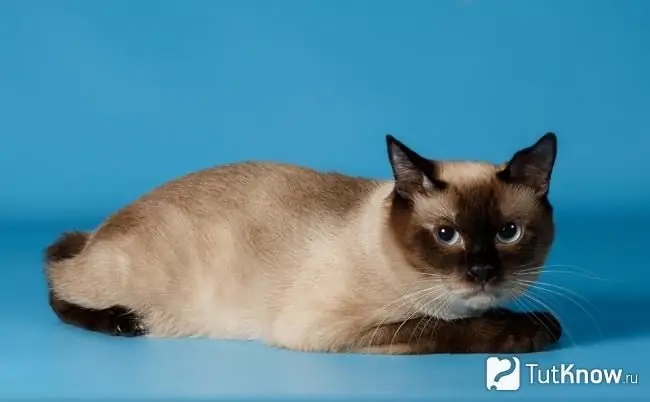
Before you start such a pet, you need to carefully familiarize yourself with his temperament, but he is not a simple one. The first thing you need to prepare yourself for is that after settling a Thai cat in the house, the owner must say goodbye to being alone forever. This animal will follow you everywhere and everywhere. The cat will never climb into his arms, or rather not always, but the fact that he will constantly watch intently with his blue eyes is for sure. Do not think that Thai cat can stop closed doors - not at all, this is not an obstacle for him, Thais are smart enough either how to open them, or a loud, persistent and extremely piercing meow, which is unlikely to leave the owners indifferent. Even if you are going to take a bath or simply go to the restroom, know that your pet will immediately have urgent, vital things to do there.
This is not because these cats are very annoying, but because the representatives of this breed cannot stand loneliness. And believe me, it's better to put up with such attention from a cat, it's worse if the animal is looking for entertainment for itself. The Thai cat, of course, will find something to do, but whether you like it is another matter. Curiosity is the trait that guides your pet's life, and in conjunction with perseverance and remarkable intelligence, it's just a nuclear mixture. It is better to immediately remove all valuable, sharp and breakable objects from the field of view and access of the pet. This also applies to the wires of electrical appliances, as soon as the cat spots them, they will become her favorite fun, and this will not lead to anything good. If it is not possible to hide the wires, then it is recommended to sprinkle them gently with lemon juice, this will scare off the fluffy. Do not think about putting everything on the top of the closet, your Thai cat will visit it more than once, and opening the closet is not a problem for him. The best way out of this situation is with lots of toys, climbing structures and your close supervision.
Voicing is another feature of Thai purrs. On your return home, know that your pet is waiting for you there with a huge number of untold stories. The cat will talk about everything for a long time, but the meow of Thai cats is very variable and melodic. If the pet is in the mood, it can be a calm, quiet tonality, if it requires your attention, or, for example, lunch - this is a different sound.
If we talk about the internal qualities of Thai cats, then they are ideal pets. They are open-minded, good-natured, funny, perky and very, very loyal. They know how to guess your mood, so if you come home gloomy and tired, believe me, your personal purring "tailed psychologist" will eliminate all problems and make every effort so that you will smile, forgetting about all the problems and troubles.
With little kids, Thai cat not only find a common language, they become best friends, because who, if not children, can tirelessly run and jump, and this is all this animal needs. For the sake of such a fun pastime, cats often turn a blind eye to some children's pranks, so it's definitely not worth worrying that the pet can release its claws in the direction of the child. Other pets in the house are great, a Thai cat will be friends with them, and it doesn't matter who it is, another cat, a huge bulldog or a turtle - for these natives of Thailand, friendship has no species restrictions.
Also Thai cat is very smart and you can easily teach him not only basic rules of behavior in the house, use a tray and scratching post, but also teach some simple tricks.
Thai cat health
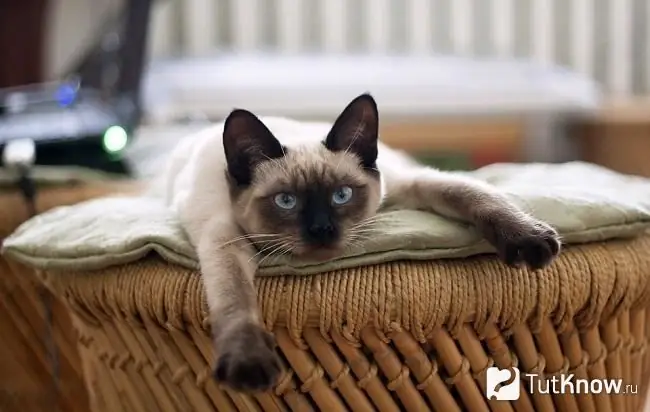
From nature, as a reward, representatives of this breed received very stable defenses of the body, but despite this, these purrs still have a genetic predisposition to some pathologies. These include kinks, bends, hooked tail, convergent squint, hypertrophic cardiomyopathy, renal and hepatic amyloidosis, and neoplastic tendencies. As for the first two problems, they are visible from the very birth of a kitten, but with the rest in terms of diagnosis, problems may arise.
Amyloidosis of internal organs is a pathological condition characterized by the deposition of a specific protein amyloid on the surface of internal organs of Thai cat. At the first stages of the disease, everything seems to be fine, but if the pet is not rescued in time, everything can end very badly, from a decrease in the functionality of vital organs to death. Unfortunately, modern medicine has not yet invented a cardinal treatment for amyloidosis, but if the disease is diagnosed at the initial stages of development, then significantly reduce the spread of amyloid, thereby prolonging and improving the life of your pet.
Hypertrophic cardiomyopathy is a chronic heart disease that also prefers to remain silent about its appearance. The whole point of the problem is that the walls of the heart chambers are slowly but surely thickening, which interferes with the normal functioning of the heart muscle. This disease does not show itself in the early stages with any specific symptoms, but it can be diagnosed. To do this, it will be enough to periodically conduct an ultrasound examination of a Thai cat. Taking certain medications can slow down the rate at which the walls of the heart expand, which will also prolong the life cycle of your pet.
Vaccination even for completely healthy animals is an extremely necessary measure, natural immunity cannot cope with all feline sores, so it needs a "reliable companion" in the face of vaccinations.
Also, do not neglect the preventive courses of anthelmintic therapy, as well as the prevention of external parasites. Sometimes such seemingly innocent problems as worms, fleas and ticks can lead to more serious, and most importantly, almost lightning-fast consequences than chronic or hereditary pathologies.
Thai Cat Care Tips
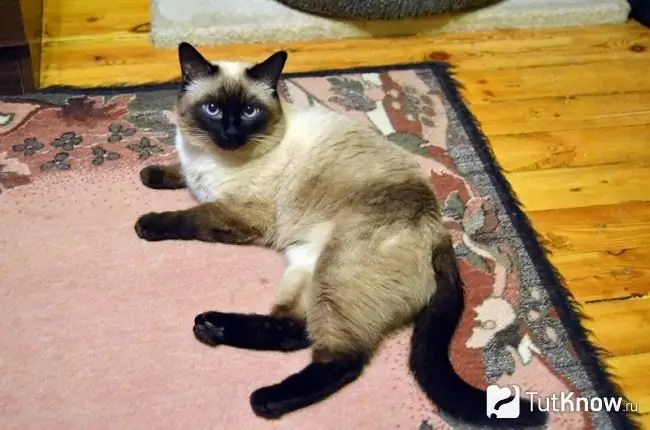
- Hair care Thai cat does not mean anything complicated by itself, since they do not have an undercoat, then their hairs do not get tangled. So brushing your pet about twice a week is more than enough at normal times. This can be done as with a massage brush, it is better to choose medium hardness with an average frequency of the teeth, or you can use a rubber glove. When a Thai cat sheds, and she sheds profusely, therefore, at this time, the optimal frequency of brushing is once or twice a day. As for bathing, these animals do not belong to those who will gladly splash in the water, so you need to wash the Thai cat only as needed, since they themselves are very clean, so they do a very good job with personal hygiene on their own.
- Hygiene. Ear cleaning should be done regularly, at least once every one and a half weeks. You need to do it with the help of cotton swabs with a limiter and a special lotion for cleaning the ears of animals. There are many such drugs in zoo pharmacies. Thai cat eye care should be done with the same frequency. In order for the cat's eyes to always be healthy and well-groomed, they need to be wiped with cotton pads (separate for each eye), previously soaked in a decoction of herbs, tea leaves, or boric acid, or potassium permanganate. The Thai cat's teeth also need to be brushed, but this should be done at least once a week, and preferably several. To do this, you will need either a soft toothbrush or a clean, lint-free cloth to wrap around your index finger. As a cleaning agent, you need to purchase powder or paste for cats. All hygiene procedures for a pet must be taught from early childhood. Then there will be the hope that he will meekly stand and wait until everything is over, there will still be.
- Leisure. Thai cats need your attention, if you cannot give it to your pet all the time, then you should come up with activities for it. Toys, cat rides, climbing trees, various tunnels and other fun are all good, but walks are also needed. It is better not to let one cat go, because due to his curiosity he can wander somewhere and get lost, and because of his beauty - he can simply be stolen, so a leash is required.
- What do they eat? Most experts unanimously insist that Thai cats need to be fed high-quality ready-to-eat foods, and this is right, because such food contains all the necessary vitamins and minerals. But you can also feed the cat with natural products, you just have to avoid seafood and liver, as they negatively affect the color of the pet's fur coat.
Price of a pedigree kitten and a photo of a Thai cat
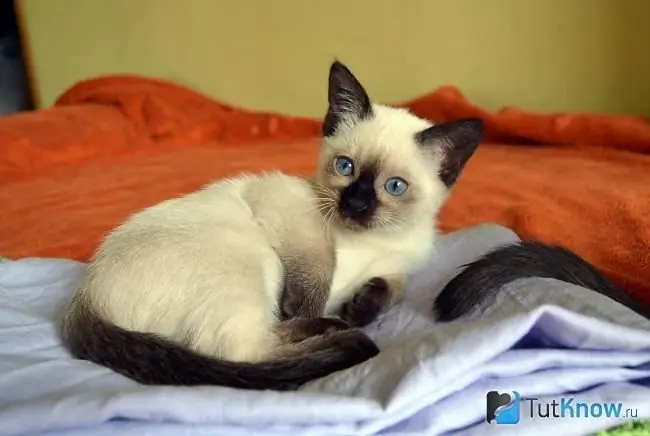
The average cost of a purebred Thai cat kitten ranges from 6,000 to 30,000 rubles, it all depends on the class of the animal, gender and the prestige of the cattery.






